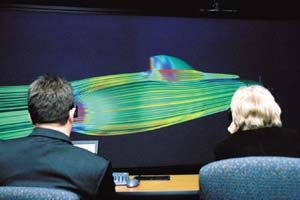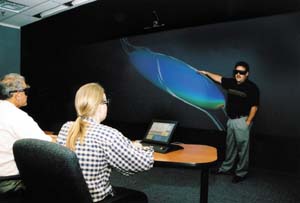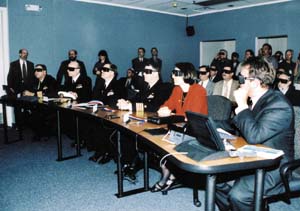Visualization Center Shapes the Future
 |
 |
The U.S. Navy’s Center for Concept Visualization (CCV) uses three-dimensional imaging to create a virtual environment for viewing hydrodynamic and hydroacoustic phenomena. |
The U.S. Navy is using virtual reality to build better warships. By molding data into three-dimensional images with cutting-edge computer systems, engineers can identify potential trouble spots on a vessel’s hull and share the information with other design teams around the country. Virtual imaging systems allow engineers to evaluate many different hull types before expensive model testing or full-scale trials occur.
Remotely connecting facilities into virtual collaborative networks allows researchers and designers to work together to create and share information about a system or platform, leading to fewer design changes during construction. Because interactive environments quickly can convey abstract research information to nonexperts, the technology could reduce a platform’s production time by highlighting problem areas to entire program teams.
One such virtual imaging system is operating at the U.S. Naval Sea Systems Command’s Naval Surface Warfare Center Carderock Division in Bethesda, Maryland. Located in the facility’s Hydrodynamic/Hydroacoustic Technology Center (H/HTC), the Center for Concept Visualization (CCV) supports the design of a variety of vessels and ship systems, from aircraft carriers to small unmanned submarines.
According to Douglas Dahmer, H/HTC operations manager, the center’s resources consist of a suite of computer servers—mini supercomputers—and direct T-1 connections to Northrop Grumman Ship Systems in Newport News, Virginia; General Dynamics Electric Boat, Groton, Connecticut; and the Penn State Applied Research Laboratory (ARL), State College, Pennsylvania. Additional network connections link the H/HTC with other groups in the military and in academia and industry, he says.
Launched in October 2003, the CCV’s goal is to help designers and program managers make better decisions early in a vessel’s design process. “It’s all about getting information to the right people at the right time. Because today’s warships are so highly optimized and all of the systems so interdependent, the sooner you can find out what kind of interdependencies a change will cause, the sooner you can deliver something,” Dahmer explains.
Speed is even more important in modifying existing ship designs to new mission requirements. The CCV’s detailed images provide design teams with the data needed to affect these new changes to help bring innovative technology out to warfighters, he says.
Growing computational and visualization needs led to the CCV’s development. Dahmer notes that engineers and scientists conducting fluid dynamics and high-end analytical work generate very large data sets. For example, computational fluid dynamics engineers routinely create 10 million to 20 million point data grids, each point representing up to 10 variable calculations. Dahmer maintains that these large data sets cannot be adequately displayed with charts or graphs. The CCV converts hydrodynamic and hydroacoustic data into real-time simulations that allow engineers to examine water flow and noise transmission in and around ships. Visualization techniques also examine a ship’s maneuvering characteristics, top speed and counterdetection ranges.
Although this data can be generated on a high-end workstation, the CCV’s size permits groups of people to enter a collaborative environment, allowing researchers, program managers and sponsors to view specific phenomenon simultaneously. The simulated data allow all the participants to understand the effects in question.
By using the CCV’s collaborative aspects, Dahmer hopes that program managers and sponsors will become more deeply involved in the design process at an earlier stage. He notes that to nonexperts, some hydrodynamic phenomena are arcane and very difficult to describe with slides or graphs. PhDs have spent many years understanding these phenomena, but to articulate what a phenomenon’s effect will be on the total platform is sometimes very difficult. “When you can do it in a more meaningful representation, it helps everybody along in the acquisition process,” Dahmer says.
The CCV does not have a modeling capability as its computer is optimized for visualization purposes. But the computer is connected to other government, commercial and academic research and design centers. Models can be ported via the network from U.S. Defense Department supercomputers or stored in the H/HTC’s mini supercomputers.
The CCV is a single-room auditorium that seats up to 25 people at three long tables, and these tables feature built-in ports for laptop computers. The center’s computer can support both classified and unclassified network access during a session.
 |
Capable of holding up to 25 people, the CCV can bring together entire program teams to view and discuss a vessel’s design specifications. |
The large viewing area also presented a graphics challenge. Located behind the screen, the three projectors provide the images for the CCV. A process called edge blending meshes the edges of the three separate images into one picture seamlessly. The Onyx system provides a better image-refresh rate for a more realistic image and smooth simulation without jerks or stops, Kortkamp says.
Dahmer admits that the system still needs some work, primarily to increase frame rate. However, he is confident that the CCV will soon provide imagery without any processing delays. “You want it to be near-real time. We’re close, but we’re not totally there. But that’s the advantage of this architecture,” he says.
Visitors view the three-dimensional (3-D) images through special glasses. But unlike those used for commercial entertainment, this eyewear features liquid crystal shutters that create a stereoscopic effect by alternately blinking each eye up to 96 times per second, creating the illusion of a 3-D shape. The projection system transmits commands to the glasses via infrared pulses.
The glasses provide the depth of perspective necessary for a full 3-D effect. For example, the CCV’s projectors can generate an image of a submarine. The computer also can create images of particle traces moving along the vessel’s hull. Areas of high speed or pressure are color-coded.
“We’ve taken tremendous amounts of data and collapsed it into something that even a non-hydrodynamicist can understand. You tell them what the color means, and they can say, ‘Oh it’s moving faster here, or ‘It has a little wiggle in the flow—there’s a vortex there.’ And if you can then explain that a vortex in that spot is a bad thing, the program manager can walk away and say, ‘Oh, a vortex is a bad thing at that spot. It needs to be worked on,’” Dahmer says.
Another advantage of the center’s 3-D visualization system is that it can be used for remote collaboration with other laboratories. The Carderock facility’s Philadelphia site has an immersive 3-D environment called a CAVE automated virtual environment. The CCV recently conducted an exercise in which both laboratories ran the same 3-D submarine model while researchers at each facility took turns controlling and manipulating the image. Dahmer notes that the CCV is almost ready to conduct regular virtual collaborative design sessions.
During the exercise with the Philadelphia facility, the CCV also had utility projectors simultaneously operating videoconferencing and PowerPoint displays. Dahmer offers that it is now possible to include teams from remote locations on a CAD walk-through of a ship design. Such collaborative efforts can reduce travel time for engineers and program managers, he says.
The image-sharing process between facilities uses very little bandwidth because data for the models is stored on computers at each site. The only information transmitted is commands to the host computer to move the image. “So we don’t need huge bandwidth, and yet we’re getting the performance that we need,” Dahmer explains.
In the future, Dahmer would like to see the CCV become a key destination for the ship design and systems community’s computational fluid dynamics work. He hopes the center also will become a major node in a network of nautical visualization centers. “We want this to be the place people think of when they want to visualize their data or present it to their sponsors or program managers,” he says.
Dahmer notes that, because modern warships are highly optimized for specific functions such as speed, stealth or low operational costs, very small changes can affect the performance of an individual system and cascade to other systems across the platform. “The challenge today is to identify those issues early in the design cycle because you don’t want to find out about them later,” he says.
The ideal situation is to locate all problems before any metal is touched in the shipyard, Dahmer says. A meaningful representation of a vessel’s characteristics early on in the process speeds the design cycle and potentially moves a ship into service more quickly. “That’s the ultimate goal here. The Holy Grail would be if we could design every component of the ship inside the computer from stem to stern. And in some areas we’re very good at that, while in others it’s still beyond the state of the art,” he observes.
Some types of physical modeling may always be necessary, he predicts. Certain hydrodynamic effects cannot be tested with current analytical tools. For these, physical models are studied in the Carderock facility’s tow tanks and water tunnels.
Dahmer hopes that future technology will reach a point where researchers use physical tests only to confirm computer modeling data. “Basically, we’re doing the ‘pull off this nose, put on that nose’ kind of thing in the computer. And we’re doing a better job of narrowing it down to two or three choices that we want to test, instead of building 15 models,” he explains.
The Navy still conducts tests on one-quarter, one-fifth and one-fourth scale models at Carderock. Physical models are necessary to test key components such as propellers. For example, the one-third scale model of the nuclear attack submarine USS Virginia is a 111-foot long unmanned autonomous vehicle. The actual vessel is approximately 377 feet long. Physical models also are necessary to measure certain effects such as explosions on hull structures, says Tom Warring, a Carderock official.
Dahmer notes that designers are very good at creating things they know, but when warfighters require something new or better, engineers must push into the unknown. When no test data exists to validate a new system, engineers are out of what he calls their “design space.” The best that computer modeling can do in these circumstances is to narrow down the number of possible choices before physical testing begins.
“If you put a real vessel into the computer and make a few changes, it will still be okay. The farther away you get from the real thing, the more strange and unusual things happen,” Warring adds.
Additional information about the Center for Concept Visualization is available on the World Wide Web at http://www.dt.navy.mil




Comments